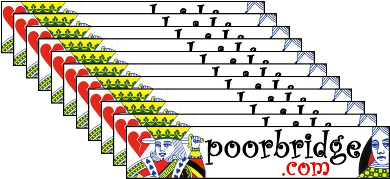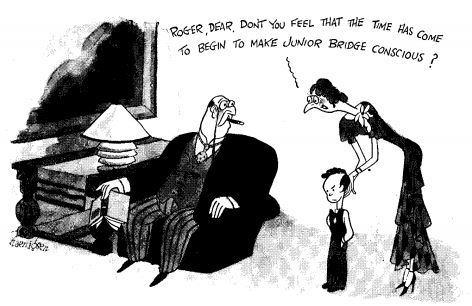
On a cold February evening, my regular partner Kees and I were at our local Bridge club, RKABC in Alkmaar, The Netherlands. Our partnership started in September the year before, after we found out we both knew how to play Bridge while playing a different card game, even though he had been one of my best friends for some years. He learned all his tricks and basic natural system from his grandfather while I acquainted myself with the game through a wonderful medium called the internet, having never read a single book on bridge. After teaching Kees about transfers, stayman, blackwood and forcing doubles, and reverting from five card majors with short club (Sayc) to all four cards (Dutch Acol) myself, we were good to go.
Over the course of this first half year I learned that my partner was at first not yet fully adjusted to artificial bids and, after that, simply not very fond of them: he passed stayman (twice), transfers (over four times) and forcing doubles without even four cards in the doubled suit (over four times)! He did understand blackwood though, as we had a mutual interest in slams and bid them too often, which sometimes made people refer to us as “slam happy”. All this contributed to our achievements on the deal described below…
Sitting South (EW vulnerable), partner passed and west opened the bidding with 1 (12+HCP, 4+
(12+HCP, 4+ ). Sitting north, I held the following:
). Sitting north, I held the following:
I would prefer a third heart to double here, but with clubs and spades I saw no problem. Partner should realize my hand is 2-suited if I decide to show spades in response to his hearts bid. So I doubled, and all problems vanished when east showed her hearts (4+ , 6+HCP).
, 6+HCP).
Kees didn’t need long to produce a 2 overcall, promising 5+ clubs and 6+ points (at this point we did not play jump responses to doubles, so he could have had any amount of points, though all outstanding HCP were pretty much bid already, so I didn’t put him at more than 9 points, including distribution). West did not seem too bothered and bid 2
overcall, promising 5+ clubs and 6+ points (at this point we did not play jump responses to doubles, so he could have had any amount of points, though all outstanding HCP were pretty much bid already, so I didn’t put him at more than 9 points, including distribution). West did not seem too bothered and bid 2 , denying 4, and probably also 3, hearts and showing a bottom range opening (12-14) with at least 6 diamonds.
, denying 4, and probably also 3, hearts and showing a bottom range opening (12-14) with at least 6 diamonds.
My instincts told me 5 was solid after partner’s bid. 6
was solid after partner’s bid. 6 was also on my mind, as was 3NT, if partner had a stopper. Even 4
was also on my mind, as was 3NT, if partner had a stopper. Even 4 was still an option, as I knew Kees would bid 2
was still an option, as I knew Kees would bid 2 rather than 1
rather than 1 with 5-4. I was afraid a double would be passed as partner doesn’t like me doubling twice without revealing information about my own hand, and may become too unconfident to bid again. Besides, a double here would not fully describe the monster hand I was now holding and there was a much better alternative: 3
with 5-4. I was afraid a double would be passed as partner doesn’t like me doubling twice without revealing information about my own hand, and may become too unconfident to bid again. Besides, a double here would not fully describe the monster hand I was now holding and there was a much better alternative: 3 ! I admit we never agreed on any meaning for bids in opponent’s suit, but this one was too obvious with West bidding a 6-card diamond suit.
! I admit we never agreed on any meaning for bids in opponent’s suit, but this one was too obvious with West bidding a 6-card diamond suit.
Lefty was dazzled by my 3 (not alerted) and passed. Kees took his time to think about my bid and drew the only logical conclusion: My double showed that diamonds was my suit as well and 3
(not alerted) and passed. Kees took his time to think about my bid and drew the only logical conclusion: My double showed that diamonds was my suit as well and 3 showed that I too held 6 diamonds! With the last outstanding diamond in his hand partner knew we had the better of them and confidently passed…
showed that I too held 6 diamonds! With the last outstanding diamond in his hand partner knew we had the better of them and confidently passed…
Being a poker player, I knew how to keep my cool and look natural, but inside I was desperately hoping for West to double so I could adjust to 5 . Alas, our opponent was made of better things and cunningly passed. As I figured there was no difference in going down much or a lot in Matchpoints, I didn’t pay much attention to the play and do not recall the lead, but dummy tabled:
. Alas, our opponent was made of better things and cunningly passed. As I figured there was no difference in going down much or a lot in Matchpoints, I didn’t pay much attention to the play and do not recall the lead, but dummy tabled:  J 6
J 6  Q 7 4 2
Q 7 4 2  5
5  K J 8 7 6 3
K J 8 7 6 3
| West | North | East | Claes Kees |
| Pass | |||
| 1 |
Doblo | 1 |
2 |
| 2 |
3 |
All Pass |
With the 6-5 club fit, 5 was cold and 6
was cold and 6 had a good chance [not sure about this — there seems to be a diamond off the top and an inescapable heart loser — Ed], the latter would make with the king of spades in West. We however chose to play the 2-1 trump fit, a fit which can normally only be achieved by passing stayman, a transfer or, apparently, by passing a cuebid.
had a good chance [not sure about this — there seems to be a diamond off the top and an inescapable heart loser — Ed], the latter would make with the king of spades in West. We however chose to play the 2-1 trump fit, a fit which can normally only be achieved by passing stayman, a transfer or, apparently, by passing a cuebid.
I managed to cash the ace of hearts and the ace and queen of spades (spade finesse worked and 6 was therefore cold [I’m still not convinced — Ed]) for a staggering 3
was therefore cold [I’m still not convinced — Ed]) for a staggering 3 -6. This hand dominated our discussion at the bar afterwards, as I was certain Kees should never ever have passed here, while he insisted that 3
-6. This hand dominated our discussion at the bar afterwards, as I was certain Kees should never ever have passed here, while he insisted that 3 could only mean I had 6 diamonds or the bid would be senseless and I should cease my silly artificial bidding.
could only mean I had 6 diamonds or the bid would be senseless and I should cease my silly artificial bidding.
I wouldn’t consider this article to be poorbridge worthy yet though, if it wasn’t for this salient detail: We scored 84% on this hand. 3 -6 undoubled, not vulnerable, was an excellent defence against contracts such as 4
-6 undoubled, not vulnerable, was an excellent defence against contracts such as 4 x+1 and 5
x+1 and 5 x=. I now regret I did not record the hands of our opponents, but will be more alert for my next article. Recently I have created a convention in which 2NT shows a singleton/void in an unknown suit, while 3NT shows two of them. Poorbridge should ensue. [Yes, we feel that should do the trick! — Ed].
x=. I now regret I did not record the hands of our opponents, but will be more alert for my next article. Recently I have created a convention in which 2NT shows a singleton/void in an unknown suit, while 3NT shows two of them. Poorbridge should ensue. [Yes, we feel that should do the trick! — Ed].
Epilogue
Where Alphonse Moyse Jr. advocated 4-3 trump fits in the majors, I would like to speak for 2-1 fits and the likes, holding this article as support. When trying to find a suit to defend in at the 3- and 4-level, do not forget opponents suit when not vulnerable. They may not double to prevent you from running away to another trump suit, which means you can lose more tricks in your sacrifice to still score a plus. Be sure to talk about this with your partner beforehand or you’ll be writing the next article for poorbridge.com. I hereby suggest 2-1 trump fits are named after our partnership.


























